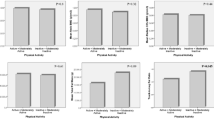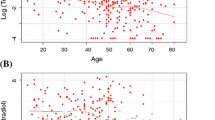Abstract
In ageing men, skeletal fragility is associated with reduced cortical thickness and decreased bone density. To better understand the role of testosterone and 17β-estradiol regarding these characteristics of skeletal fragility, we correlated their circulating levels with the estimates of mechanical bone properties derived from areal bone mineral density (aBMD) measured by DXA. External diameter and BMD were used to estimate cortical thickness, cross-sectional area (CSA), section modulus, buckling ratio and strength index of the femoral neck and distal radius on 760 men aged 40–85 years. The 17β-estradiol level was an independent positive determinant of CSA, aBMD and estimated cortical thickness of both bones. In multivariate models adjusted for age, body weight, height, lean body mass and testosterone concentration, men in the lowest quartile of 17β-estradiol had lower CSA at the femoral neck (4.8%, P<0.001) and distal radius (3.6%, P<0.01) compared with men in the highest quartile. They had also thinner cortical bone at the femoral neck and distal radius (4.8%, P<0.001 and 4.6%, P<0.001, respectively). Furthermore 17β-estradiol had a negative association with indices of cortical instability (buckling ratio) and a positive association with bending strength (section modulus, strength index) both at femoral neck and radius. Men in the lowest quartile of 17β-estradiol had higher buckling ratios (femoral neck 4.8%, P<0.002; radius 5.1%, P<0.005), lower strength index (femoral neck 8.5%, P<0.001, radius 6.1%, P<0.01) and greater section modulus at the femoral neck. However, there were no between-quartile differences in external diameter in any bone sites. Similar, even though somewhat smaller, between-quartile differences were found for bioavailable 17β-estradiol. Neither total testosterone nor apparent free testosterone concentration was associated with any bone variables after adjusting for age, body weight, body height, and lean body mass and 17β-estradiol level. In conclusion, in elderly men, low concentration of 17β-estradiol (total and bioavailable) was associated with a decreased cortical thickness and with a deterioration of biomechanical parameters of long bones (lower section modulus and strength index, higher buckling ratio).




Similar content being viewed by others
References
Seeman E (2002) Pathogenesis of bone fragility in women and men. Lancet 359:1841–1850
Ravaglia G, Forti P, Maioli F, Nesi B, Pratelli L, Cucinotta D, Bastagli L, Cavalli G (2000) Body composition, sex steroids, IGF-I, and bone mineral status in aging men. J Gerontol Med Sci Biol Sci 55A:M516–M521
Amin S, Zhang Y, Sawin CT, Evans SR, Hannan MT, Kiel DP, Wilson PWF, Felson DT (2000) Association of hypogonadism and estradiol levels with bone mineral density in elderly men from the Framingham study. Ann Int Med 133:951–963
Drinka PJ, Olson J, Bauwens S, Voeks SK, Carlson I, Wilson M (1993) Lack of association between free testosterone and bone density separate from age in elderly males. Calcif Tissue Int 52:67–69
Slemenda CW, Longcope C, Zhou L, Hui SL, Peacock M, Johnston CC (1997) Sex steroids and bone mass in older men. Positive associations with serum estrogens and negative associations with androgens. J Clin Invest 100:1755–1759
Khosla S, Melton LJ III, Atkinson EJ, O’Fallon WM, Klee GG, Riggs BL (1998) Relationship of serum sex steroid levels and bone turnover markers with bone mineral density in men and women: a key role for bioavailable estrogen. J Clin Endocrinol Metab 83:2266–2274
Greendale GA, Edelstein S, Barrett-Connor E (1997) Endogenous sex steroids and bone mineral density in older women and men: the Rancho Bernardo study. J Bone Miner Res 12:1833–1843
Barrett-Connor E, Mueller JE, von Mühlen DG, Laughlin GA, Schneider DL, Sartoris DJ (2000) Low levels of estradiol are associated with vertebral fractures in older men, but not women: the Rancho Bernardo study. J Clin Endocrinol Metab 85:219–223
Szulc P, Munoz F, Claustrat B, Garnero P, Marchand F, Duboeuf F, Delmas PD (2001) Bioavaiable estradiol may be an important determinant of osteoporosis in men: the MINOS study. J Clin Endocrinol Metab 86:192–199
Khosla S, Melton LJ III, Atkinson EJ, O’Fallon WM (2001) Relationship of serum sex steroid levels to longitudinal changes in bone mineral density in young versus elderly men. J Clin Endocrinol Metab 86:3555–3561
11 Eriksson S, Eriksson A, Stege R, Carlström K (1995) Bone mineral density in patients with prostatic cancer treated with orchidectomy and with estrogens. Calcif Tissue Int 57:97-99
Kesteren P van, Lips P, Deville W, Popp-Snijders C, Asscheman H, Megens J, Gooren L (1996) The effect of one-year cross-sex hormonal treatment on bone metabolism and serum insulin-like growth factor-1 in transsexuals. J Clin Endocrinol Metab 81:2227–2232
Falahati-Nini A, Riggs BL, Atkinson EJ, O’Fallon WM, Eastell R, Khosla S (2000) Relative contributions of testosterone and estrogen in regulating bone resorption and formation in normal elderly men. J Clin Invest 106:1553–1560
Leder BZ, LeBlanc KM, Schoenfeld DA, Eastell R, Finkelstein JS (2003) Differential effects of androgens and estrogens on bone turnover in normal men. J Clin Endocrinol Metab 88:204–210
Taxel P, Kennedy DG, Fall PM, Willard AK, Clive JM, Raisz LG (2001) The effect of aromatase inhibition on sex steroids, gonadotropins, and markers of bone turnover in older men. J Clin Endocrinol Metab 86:2869–2874
Khosla S, Riggs BL (2003) Androgens, estrogens, and bone turnover in men. J Clin Endocrinol Metab 88 2352–2353
Seeman E (1999) Bone size, mass, and volumetric density: the importance of structure in skeletal health. In: Orwoll ES (ed) Osteoporosis in men. The effects of gender on skeletal health. Academic Press, San Diego, pp 87–109
Orwoll ES, Klein RF (1996) Osteoporosis in men. Epidemiology, pathophysiology, and clinical characterization. In: Marcus R, Feldman D, Kelsey J (eds) Osteoporosis. Academic Press, New York, pp 745–784
Szulc P, Marchand F, Duboeuf F, Delmas PD (2000) Cross-sectional assessment of age-related bone loss in men. Bone 26:123–129
Hans D, Dubeouf F, Schott AM, Horn S, Avioli LV, Drezner MK, Meunier PJ (1997) Effects of a new positioner on the precision of hip bone mineral density measurements. J Bone Miner Res 12:1289–1294
Martin R, Burr D (1984) Non-invasive measurement of long bone cross-sectional moment of inertia by photon absorptiometry. J Biomech 17:195–201
Carter DR, Bouxsein ML, Marcus R (1992) New approaches for interpreting projected bone densitometry data. J Bone Miner Res 7:137–145
Beck T, Looker AC, Ruff CB, Sievanen H, Wahner HW (2000) Structural trends in the aging femoral neck and proximal shaft: analysis of Third National Health and Nutrtion Examination Survey dual-energy X-ray absorptiometry data. J Bone Miner Res 15:2297–2304
Rey P, Sornay-Rendu E, Garnero P, Vey-Marty B, Delmas PD (1994) Measurement of forearm bone mineral density by X-ray absorptiometry: comparison with other skeletal sites. Rev Rhum 61:548–554
Boivin G, Meunier PJ (2002) The degree of mineralization of bone tissue measured by computerized quantitative contact microradiography. Calcif Tissue Int 70:503–511
Hsu ES, Patwardhan AG, Meade KP, Light TR, Martin WR (1993) Cross-sectional geometrical properties and bone mineral contents of human radius and ulna. J Biomech 26 1307–1318
Bremond AG, Claustrat B, Rudigoz RC, Seffert P, Corniau J. (1982) Estradiol, androstenedione, and dehydroepiandrosterone sulfate in the ovarian and peripheral blood of postmenopausal patients with and without endometrial cancer. Gynecol Oncol 14:119–124
Vermeulen A, Stoïca T, Verdonck L (1971) The apparent free testosterone concentration, an index of androgenicity. J Clin Endocrinol 33:759–767
Vermeulen A, Verdonck L, Kaufman JM (1999) A critical evaluation of simple methods for the estimation of free testosterone in serum. J Clin Endocrinol Metab 84:3666–3672
Södegard R, Bäckström T, Shanbhang V, Carstensen H (1982) Calculation of free and bound fractions of testosterone and estradiol-17β to human plasma proteins at body temperature. J Steroid Biochem 16 801–810
Kaptoge S, Dalzell N, Loveridge N, Beck TJ, Khaw KT, Reeve J (2003) Effects of gender, anthropomorphic variables and aging on the evolution of hip strength in men and women over 65. Bone 2003 32 561–570
Stepan JJ, Lachman M, Zverina J, Pacovsky V, Baylink DJ (1989) Castrated men exhibit bone loss: effects of calcitonin treatment on biochemical indices of bone remodeling. J Clin Endocrinol Metab 69:523–527
Leifke E, Körner HC, Link TM, Behre HM, Peters PE, Nieschlag E (1998) Effects of testosterone replacement therapy on cortical and trabecular bone mineral density, vertebral body area and paraspinal muscle area in hypogonadal men. Eur J Endocrinol 138:51-58
Beld AW van den, Jong FH de, Grobbee DE, Pols HAP, Lamberts SWJ (2000) Measures of bioavailable serum testosterone and estradiol and their relationships with muscle strength, bone density, and body composition in elderly men. J Clin Endocrinol Metab 85:3276–3282
Colvard DS, Eriksen EF, Keeting PE, Wilson EM, Lubahn DB, French FS, Riggs BL, Spelsberg TC (1989) Identification of androgen receptors in normal human osteoblast-like cells. Proc Natl Acad Sci USA 86:854–857
Mizuno Y, Hosoi T, Inoue S, Ikegami A, Kaneki M, Akedo Y, Nakamura T, Ouchi Y, Chang C, Orimo H (1994) Immunocytochemical identification of androgen receptor in mouse osteoclast-like multinucleated cells. Calcif Tissue Int 54:325–326
Kasperk CH, Wakley GK, Hierl T, Ziegler R (1997) Gonadal and adrenal androgens are potent regulators of human bone cell metabolism in vitro. J Bone Miner Res 12:464–471
Gori F, Hofnauer MC, Conover CA, Khosla S (2000) Effects of androgens on the insulin-like growth factor system in an androgen-responsive human osteoblastic cell line. Endocrinology 140:5579–5586
Pederson L, Kremer M, Judd J, Pascoe D, Spelsberg TC, Riggs BL, Oursler MJ (1999) Androgens regulate bone resorption activity of isolated osteoclasts in vitro. Proc Natl Acad Sci 96:505–510
Huber DM, Bendixen AC, Pathrose P, Srivastava S, Dienger KM, Shevde NK, Pike JW (2001) Androgens suppress osteoclast formation induced by RANKL and macrophage-colony stimulating factor. Endocrinology 142:3800–3808
Vanderschueren D, Boonen S, Ederveen AGH, de Coster R, van Herck E, Moermans K, Vandenput L, Verstuyf A, Bouillon R (2000) Skeletal effects of estrogen deficiency as induced by an aromatase inhibitor in an aged male rat model. Bone 27:611–617
Vanderschueren D, van Herck E, Suiker AMH, Visser WJ, Schot LPC, Bouillon R (1992) Bone and mineral metabolism in aged male rats: short and long term effects of androgen deficiency. Endocrinology 130:2906–2916
Wakley GK, Schutte HD Jr, Hannon KS, Turner RT (1991) Androgen treatment prevents loss of cancellous bone in the orchidectomised rat. J Bone Miner Res 6:325–329
Turner RT, Wakley GK, Hannon KS (1990) Differential effects of androgens on cortical bone histomorphometry in gonadectomized male and female rats. J Orthop Res 9:612–617
Vanderschueren D, van Herck E, Suiker AMH, Visser WJ, Schot LPC, Chung K, Lucas RS, Einhorn TA, Bouillon R (1993) Bone and mineral metabolism in the androgen-resistant (testicular feminized) male rat. J Bone Miner Res 8:801–808
Vanderschueren D, van Herck E, Nijs J, Ederveen AGH, de Coster R, Bouillon R (1997) Aromatase inhibition impairs skeletal modeling and decreases bone mineral density in growing male rats. Endocrinology 1997 138:2301–2307
Acknowledgement
This study was supported by a grant from INSERM/Merck Sharp & Dohme Chibret, France.
Author information
Authors and Affiliations
Corresponding author
Additional information
Presented in abstract form at the World Congress of Osteoporosis, Lisbon, Portugal, 2002.
Rights and permissions
About this article
Cite this article
Szulc, P., Uusi-Rasi, K., Claustrat, B. et al. Role of sex steroids in the regulation of bone morphology in men. The MINOS study. Osteoporos Int 15, 909–917 (2004). https://doi.org/10.1007/s00198-004-1635-0
Received:
Accepted:
Published:
Issue Date:
DOI: https://doi.org/10.1007/s00198-004-1635-0




